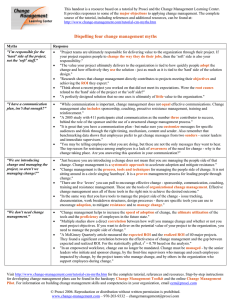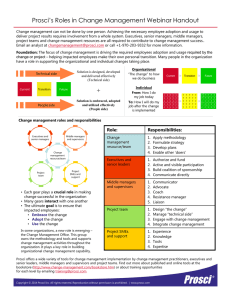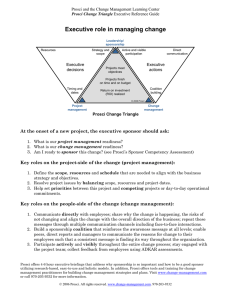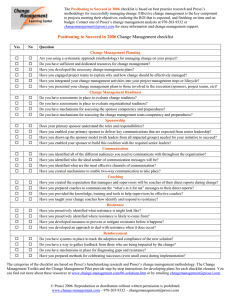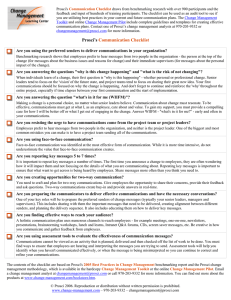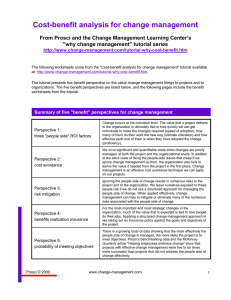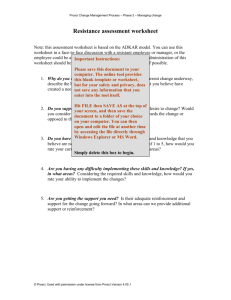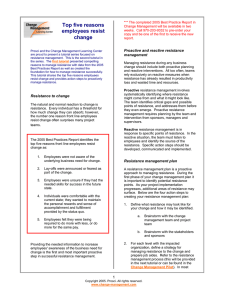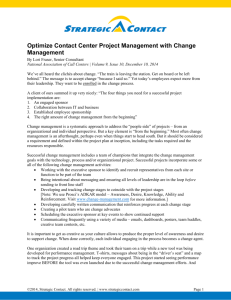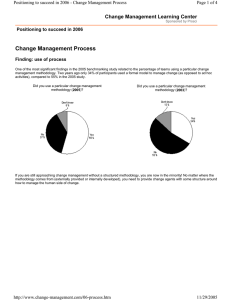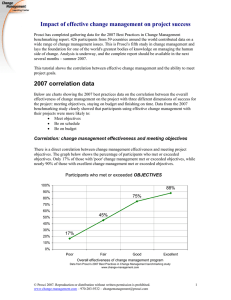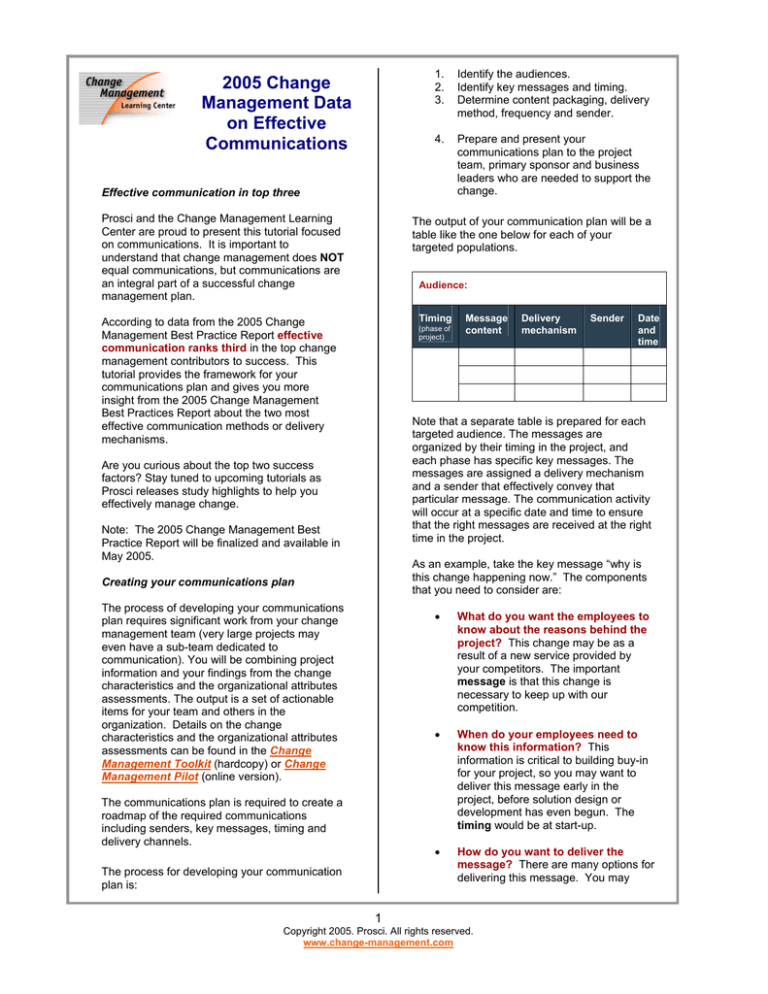
2005 Change
Management Data
on Effective
Communications
1.
2.
3.
Identify the audiences.
Identify key messages and timing.
Determine content packaging, delivery
method, frequency and sender.
4.
Prepare and present your
communications plan to the project
team, primary sponsor and business
leaders who are needed to support the
change.
Effective communication in top three
Prosci and the Change Management Learning
Center are proud to present this tutorial focused
on communications. It is important to
understand that change management does NOT
equal communications, but communications are
an integral part of a successful change
management plan.
The output of your communication plan will be a
table like the one below for each of your
targeted populations.
Audience:
Timing
According to data from the 2005 Change
Management Best Practice Report effective
communication ranks third in the top change
management contributors to success. This
tutorial provides the framework for your
communications plan and gives you more
insight from the 2005 Change Management
Best Practices Report about the two most
effective communication methods or delivery
mechanisms.
(phase of
project)
Message
content
Delivery
mechanism
Sender
Date
and
time
Note that a separate table is prepared for each
targeted audience. The messages are
organized by their timing in the project, and
each phase has specific key messages. The
messages are assigned a delivery mechanism
and a sender that effectively convey that
particular message. The communication activity
will occur at a specific date and time to ensure
that the right messages are received at the right
time in the project.
Are you curious about the top two success
factors? Stay tuned to upcoming tutorials as
Prosci releases study highlights to help you
effectively manage change.
Note: The 2005 Change Management Best
Practice Report will be finalized and available in
May 2005.
As an example, take the key message “why is
this change happening now.” The components
that you need to consider are:
Creating your communications plan
The process of developing your communications
plan requires significant work from your change
management team (very large projects may
even have a sub-team dedicated to
communication). You will be combining project
information and your findings from the change
characteristics and the organizational attributes
assessments. The output is a set of actionable
items for your team and others in the
organization. Details on the change
characteristics and the organizational attributes
assessments can be found in the Change
Management Toolkit (hardcopy) or Change
Management Pilot (online version).
The communications plan is required to create a
roadmap of the required communications
including senders, key messages, timing and
delivery channels.
The process for developing your communication
plan is:
•
What do you want the employees to
know about the reasons behind the
project? This change may be as a
result of a new service provided by
your competitors. The important
message is that this change is
necessary to keep up with our
competition.
•
When do your employees need to
know this information? This
information is critical to building buy-in
for your project, so you may want to
deliver this message early in the
project, before solution design or
development has even begun. The
timing would be at start-up.
•
How do you want to deliver the
message? There are many options for
delivering this message. You may
1
Copyright 2005. Prosci. All rights reserved.
www.change-management.com
Remember, participants stated that effective
communications was the third most important
contributor to success. This tutorial provided a
process for systematically developing your
communications plan and shared some of the
most effective delivery methods identified by
study participants. The new best practices study
will include additional benchmarking data
regarding communications - including essential
messages to communicate, key senders of
messages and what teams would do differently.
For a complete communications plan template,
see the Change Management Toolkit or
Change Management Pilot.
decide that a one-hour department
meeting is the appropriate delivery
mechanism for this message.
•
Who should deliver the message to
your employees? Messages around
the business reasons to change are
typically best received from senior
leaders and executives. You may
identify the COO as the appropriate
sender, and bring her in for a 30minute presentation during your
meeting.
•
When will the meeting take place?
After examining the project timeline,
you may pick January 10 at 11:00 as
the date and time of your department
meeting.
Summary
As a project team or change management team,
your efforts in building a communications plan
are important, but your efforts are equally as
important to build the plans that go along with
the communications plan. Change
management does not equal communications
only. To be effective in your change, you need
to build a communications plan along with a
sponsor roadmap, coaching plan, training plan
and resistance management plan. For a
complete set of descriptions, templates,
checklists and worksheets on each of the above
plans please see the Change Management
Toolkit (hardcopy) or Change Management
Pilot (online version).
2005 change management best practice data
The frequency and mode to communicate
change in organizations varies but the
resounding message learned from participants
was that the majority had a comprehensive
communication plan to roll out the message
pertaining to change within their organizations.
The methods most frequently cited were:
•
•
•
•
•
•
E-mail
Group meetings (cascading message
delivered throughout the organization)
One-on-one communication
Company publications (i.e. newsletters
and magazines)
Intranet
High level and executive storytelling
delivered company-wide
The two most effective communications
methods (delivery mechanisms), according to
the 2005 Change Management Best Practice
Report, were:
•
One-on-one or face-to-face
discussions that are honest and
straight forward and that offer details of
the change one a personal level.
"People in the organization focused
much more on personal interactions
than reading information."
•
Cascading small group meetings to
share information, brainstorm solutions
and implement new processes.
"We provided all managers with the
same tools and messages so that
managers across the system delivered
a common message."
2
Copyright 2005. Prosci. All rights reserved.
www.change-management.com
Resource guide
Benchmarking Reports and Toolkits
Books and Resources to distribute
Best Practices in Change Management: 288
companies share experiences in managing
change and lesson on how to build great
executive sponsorship. Includes success
factors, methodology, role of top management,
communications, team structure and more. The
report makes it easy to learn change
management best practices and discover the
mistakes to avoid when creating executive
sponsorship.
Change Management: the people side of
change: a solid foundation in change
management perspectives, theories, activities
and practices.
Employee's Survival Guide to Change:
answers questions most employees are
unwilling to ask and uncovers what it takes to
survive and thrive in today’s changing
workplace. Employees will learn the ADKAR
model and become effective change agents,
instead of difficult change barriers.
Change Management Toolkit: a
comprehensive change management process,
including templates, worksheets, assessments,
checklists and guidelines - a must have for
change management team members and
consultants.
Change Management Guide for Managers
and Supervisors: a guide specifically designed
for managers and supervisors dealing with
change - complete with team and individual
coaching activities, best practices findings and
frequently asked questions.
Online tools
Change Management Pilot: a fully electronic
version of Prosci's popular change management
toolkit with templates, worksheets,
assessments, checklists, eLearning modules,
ready-to-use presentations and guidelines.
Change Management Pilot Professional: a
fully electronic version that combines the
Change Management Pilot with the Change
Management Guide for Managers and
Supervisors and Employee’s Survival Guide - a
combination that allows you to reach each level
of the organization.
3
Copyright 2005. Prosci. All rights reserved.
www.change-management.com

